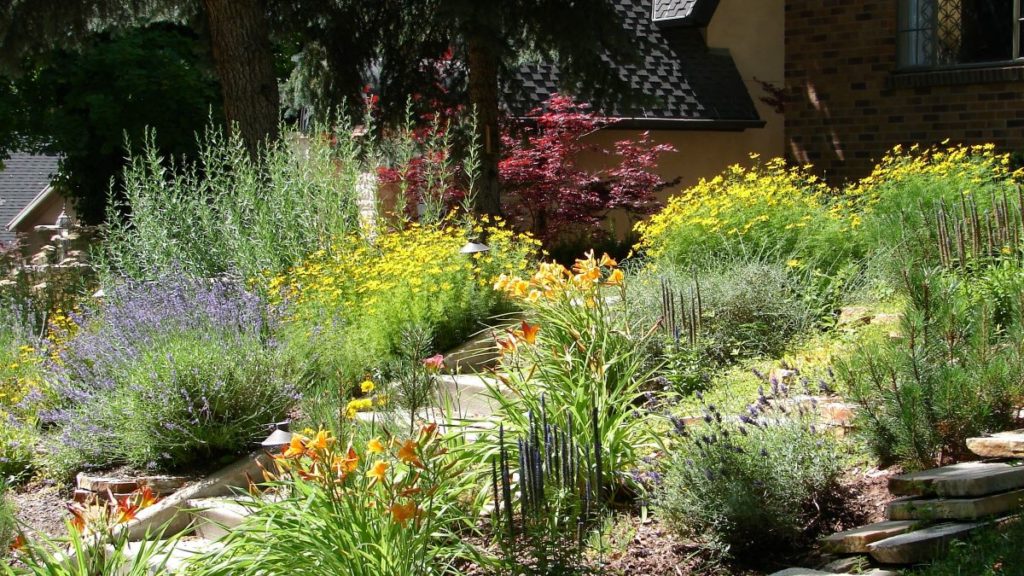
Xeriscaping 101: Landscaping With Minimal Water

If you wish your garden used zero water, a xeriscape might be right for you. Xēros is the Greek word for “dry.” So a xeriscape is a dry landscape. For a lot of people, the word xeriscape evokes a harsh, barren image. But a dry landscape doesn’t have to look dry. Even a true desert landscape can be much softer and greener than just a scattering of cacti spiking out of a swath of gravel or lava rock. In fact, a good xeriscape won’t always look much different from any other garden to a casual observer. But it will use a lot less water.
This article contains affiliate links. If you purchase an item through one of these links, we receive a small commission that helps fund our Recycling Directory.
Xeriscape
Xeriscaping is not an aesthetic style. Rather, it’s a water-wise approach to maintaining a healthy garden with a minimum of supplemental water. Ideally, a xeriscape would only require watering to help establish new plants, during droughts, or during unusually hot and dry weather. Whether you live in a perpetually dry climate or one with a defined wet/dry seasonal pattern, occasional deep watering in rain-free months will expand the available plant palette and allow for a much lusher garden. Regardless of climate, xeriscaping relies on careful planning and smart plant selection, supported by water-wise landscape maintenance practices.
Complement Your Climate
The most important principle of xeriscaping is to understand your local climate and work with, rather than against it. If you live in a desert, most of the plants used in a traditional cottage garden will struggle to survive even with lots of supplemental water. Instead of fighting to grow moisture-loving plants in the desert or to keep tropical plants alive in a dry summer climate, look for plants that match the conditions where you live.
Natives are the obvious choice, but nativars can expand your palette. You can even look for exotics from areas with similar climates. For example, the coastal Pacific Northwest’s rainy winters and dry summers echo growing conditions in the Mediterranean and New Zealand. If you truly love a particular garden style, you can still utilize some of its design principles with locally appropriate species, for example, planting native perennials in loosely pruned drifts to evoke a cottage garden.
Smart Design
The principles of xeriscaping go beyond plant selection to include design, soil care, irrigation, and maintenance. Although your plant selection is site-specific, smart design strategies will work in a variety of situations. Place plants with similar requirements together so that any supplemental watering can be concentrated in fewer areas. Hardscaping can be used to direct stormwater to planted areas as well. Careful placement of rocks and decorative features, as well as some plant combinations, can create windbreaks and shading to develop microclimates that support plant growth with less water. In most cases, it is not possible to maintain a lawn without supplemental water. So no matter what climate you live in, xeriscaping requires you to eliminate lawn. However, it is not always necessary to replace your entire landscape – incremental change can be the best choice.
Soil Solutions
Similar to dry gardening and any other sustainable approach to gardening, soil health is critical to xeriscaping. Healthy soil is capable of storing large amounts of water for an extended period, eliminating the need for supplemental irrigation. Although it’s very hard to change soil’s texture with amendments, they can help clay or sandy soil hold water. No matter what kind of soil you have, mulching is one of the best things you can do for your soil’s health. It also helps keep prevent evaporation from the soil.
Water-Wise Maintenance
If you can’t give up your entire lawn, at least allow it to go gold during the dry season – it will come back with the rains. If you do need to water, do so rarely, but deeply. Saturate the soil to a depth of inches, rather than simply wetting the surface. To water most efficiently, use soaker hoses rather than sprinklers or simply spray from the hose.
To learn more about xeriscaping, books like the Xeriscape Handbook and Xeriscape Plant Guide are helpful resources. You can also check your local municipality’s website and county extension office for the specific plants and techniques that work best where you live.
Originally published on September 28, 2021, this article was updated in May 2023.
Services Marketplace – Listings, Bookings & Reviews